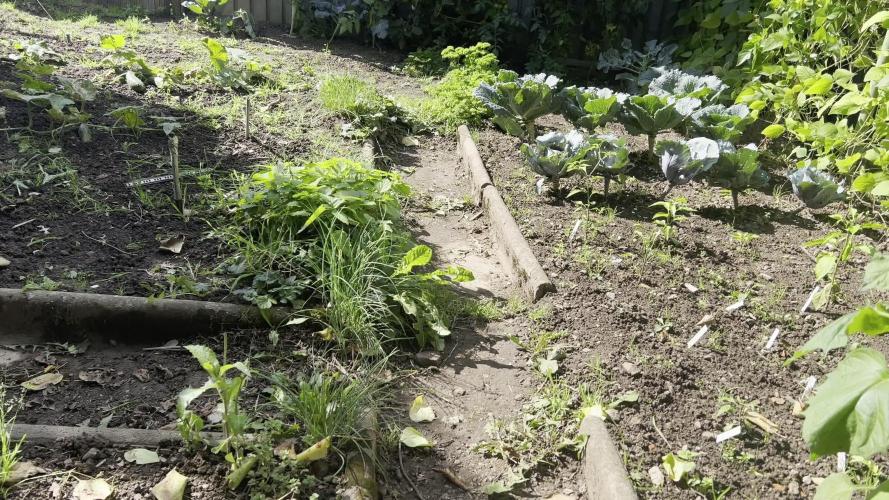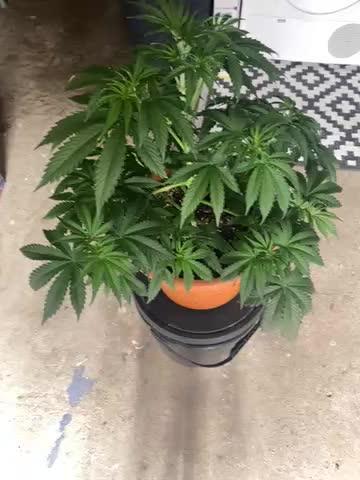The Grow Awards 2026 🏆 



































Likes
Comments
Share


@la_piper
Follow
29дней
Сделал дефолиацию и растянул ветки.
Сегодня впервые внёс Удобрения.
Жижа универсальная 1.4г/л.,бад монстр 2мл/л по листу.
Likes
12
Share


@rickhaZe
Follow
debido a quemaduras que encontre en las plantas el dia 14/06, dia 29 desde germinacion, debi regar con cal max, ya que creo que hay falta de calcio - magnesio. aplique 1.2 ml por litro de agua.
no creo que sea exceso de ferti ya que todos riegos se han preparado con la dosis minima que indica.
se sigue regando con 0.4 L cada 48hrs
una tecnica que he hecho es ir acomodando o doblando las hojas hacia abajo dando prioridad a los bracitos de cada planta.
Dia 30: riego de agua 600 ml de agua
Dia 32: todas las plantas en floracion
Aplicamos solo tek groow ya que las manchas en las plantas se debian a falta de azúfre lo concluimos con un grupo de amigos todos growers y un agrónomo.
Por que queremos continuar con la tabla de grotek nutrients y el domingo dia 34 aplicar blossom blaster
Likes
2
Share


@Wazowskid
Follow
Las plantas van creciendo estupendamente, de momento no les he dado ningún tipo de fertilizante. He aplicado LST.
Likes
9
Share


@DRO420
Follow
Second week of Veg and they are growing fast , very healthy, no deficiencies , perfect color green.
Likes
17
Share


@eldruida_lamota
Follow
Que pasa familia, actualizamos la 3 semana de crecimiento de las Purple OG kush de Dutchfem , una está increíble, iremos viendo cómo progresan pero mal color tampoco tienen.
Agrobeta:
https://www.agrobeta.com/agrobetatiendaonline/36-abonos-canamo
Mars hydro:
Code discount: EL420
https://www.mars-hydro.com/
La humedad es la correcta y la temperatura mínima 19.5 máxima 24, No me puedo quejar.
El Ph lo regulo en 6.5 ,con un medidor que son gotas controlo bien el ph.
Hasta aquí es todo espero que estéis disfrutando como yo lo hago actualizando y viéndolas progresar, Buenos humos 💨💨💨
Likes
34
Share


@Dunk_Junk
Follow
19.5cm/7.75" growth this week! Her flowers have developed very fast over this week.
Likes
4
Share


@eldruida_lamota
Follow
Que pasa familia, vamos con la cosecha de estas Papaya Zoap F1 de Sweetseeds.
Esta variedad me resultó bastante sencilla de cultivar, y si no la maltratas crece sana a mi parecer, la flor se ve increíble, tiene una cantidad de resina considerable y unos tonos muy peculiares, se ven muy apetecibles.
El olor que desprende es muy peculiar es muy dulce y empalagoso, a mi parecer, no pinta nada mal, las flores están muy prietas y la tricomada es inmejorable.
La única queja que voy a tener es que de las 3 plantas que las 3 huelen muy bien , 1 está llena de semillas, así que haré hash con esa planta. De ahí las 7 estrellas sobre 10, de no ser por eso dudaría en un 9 pero es que me parece una putada meses trabajando y pfff, repleta de seeds. Lástima por esa planta , las otras 2 muy top, van sin semilla y no se follo nada.
Hasta aquí todo, Buenos humos 💨💨💨
Likes
62
Share


@Tubington9
Follow
Day 50 Both plants received their first feeding of Future Harvest Holland Secret 3 part combo and in less than 12 hours have perked up and look very energetic! If all goes well I will hopefully flipping to bloom in week 9 or 10
Likes
8
Share


@Weedman420high
Follow
Very excited to grow my first genetics from sweet seeds, they really sorted me out with some free seeds to check them out!! Week one and they have germinated fine will just keep watering for now.
Likes
40
Share


@Teamdirtbag2
Follow
She is starting to fade on her own... I will start flushing her today... 👊😎
Likes
120
Share


@Tazard
Follow
Beginning of week 3 of flower. Should be nearing the end of the stretch but if she can give just a little more we will get the screen full! Should be a great week will add more pics!
Processing
Likes
3
Share


@Andres
Follow
Nothing important to say... she s growing up strong ang healthy outdoor
Likes
7
Share


@ChitownCannaChica
Follow
Hard to keep this little lady from constantly falling over and properly watered, but the lemon auto is plugging along! Probably another 3 weeks! ✌️💚🌿💨
Likes
11
Share


@MrPistil420
Follow
1 - 2 week left before Harvest!! Smells like Grape and Blueberry if anyone's had blueberry hash they would understand what I'm smelling .Not A Huge yield but quality should be !
Likes
28
Share


@eldruida_lamota
Follow
Que hay familia, vamos con la sexta semana de floración de estas Apple Fritter de Zamnesia.
La temperatura está entre los 21/24 grados, la humedad está entorno al 55%, y el ph lo mantengo ahora al principio en 6.2, el foco por supuesto está enchufado 12 horas , estan creciendo bien fuertes.
Y aparte añadimos nutrientes de Agrobeta, que no puede faltar semejante gama.
Todo correcto hasta ahora, ya empiezan a formarse las flores y ya están produciendo tricomas, estas próximas semanas veremos cómo avanzan.
Os comento que tengo un descuento y para que compréis en la web de Zamnesia de un 20%, el código es ZAMMIGD2023
The discount 20% and the code is ZAMMIGD2023
https://www.zamnesia.com/
agrobeta: https://www.agrobeta.com/agrobetatiendaonline/36-abonos-canamo
Mars hydro:
Code discount: EL420
https://www.mars-hydro.com/
Hasta aquí es todo, buenos humos 💨💨💨.
Likes
9
Share


@TKCS_Pinoy
Follow
🌸 Woche 15 – Week 15 Gorilla Zkittlez (Fast Buds) – Outdoor Summer
🌡️ Wetter: Etwas Sonne, immer noch Regen, aber endlich mal stabiler – der Sommer zeigt ein kleines Herz 💛.
📏 Wachstum: Höhe unverändert, die Energie steckt voll in den Buds.
💡 Licht & Energie: Mehr Sonne = mehr Power. Man sieht’s direkt an den Blüten.
🌿 Blattgesundheit: Gesund und vital, grün wie frisch aus der Werbung 🌿.
💧 Wasser & Nährstoffe: Regen erledigt den Grundjob, Kein Dünger.
🔄 Entwicklung: Jetzt wird’s ernst – Buds sind dick, sticky und super hübsch. Und ja, das ist tatsächlich die beste Pflanze aus meinem diesjährigen Outdoor-Grow 🏆. Die anderen liefern auch, aber nicht so wunderschön wie diese Lady. Bin echt stolz drauf!
✅ Fazit: Nächste Woche kommt das letzte Update, danach wird geerntet ✂️🍃. Finale Staffel-Folge incoming 🎬😂.
.....................................................................................................................................................................................................................................................................
🌸 Week 15 – Gorilla Zkittlez (Fast Buds) – Outdoor Summer
🌡️ Weather: Still rainy, but finally more balanced – summer showing a bit of mercy 💛.
📏 Growth: Height stays the same, all energy is going straight into the buds.
💡 Light & Energy: More sun = more power. Flowers are clearly loving it.
🌿 Leaf Health: Healthy, strong, deep green – like a plant commercial 🌿✨.
💧 Water & Nutrients: Rain for basics, nutrients only from Mother earth.
🔄 Development: Buds are now fat, sticky, and just gorgeous. And honestly – this is the best plant of my outdoor season 🏆. The others are fine, but not as stunning as this one. Really proud of her!
✅ Overall: Next week will be the final upload, then it’s harvest time ✂️🍃. Season finale is coming 🎬😂.
Likes
29
Share


@Silverback_Guerilla
Follow
12/21:
Added a TNB CO2 maker to the tiny tent...
12/22:
Fed today.
This tent REEKS!!!
12/26:
Fed today.
12/27:
Switched to a pair of Mars Hydro TS1000W 150w lights.
Likes
10
Share


@mikheil007
Follow
At the beginning of the week I thought it would be a harvest week, but it drives me crazy: as it goes on to develop so greatly that I am not sure it will be done in more couple of weeks!...





















